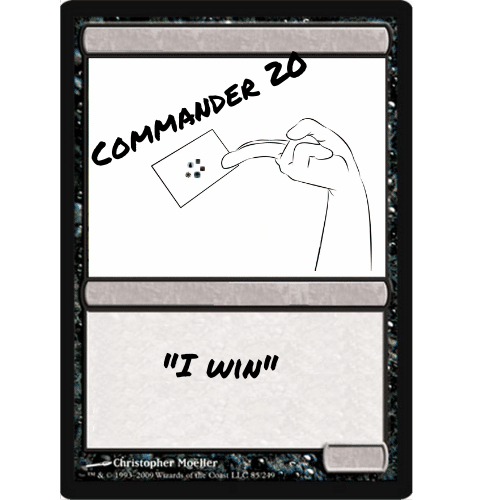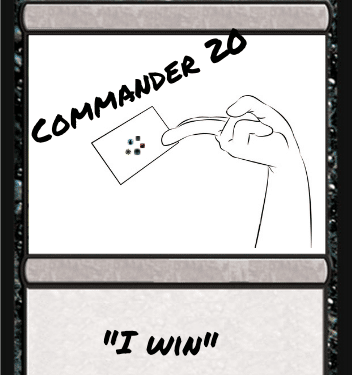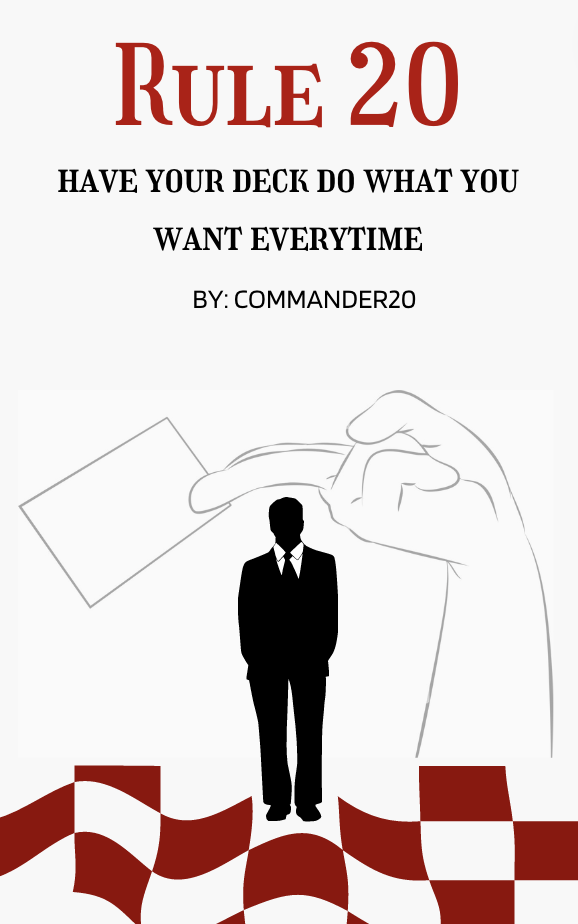
Looking for a Commander Deck Building Template! Whether you are new or looking for a fresh take on how to build a commander deck, commander20 has you covered.
A good commander deck building template has 4 steps
- Step 1: Choose Your Commander
- Step 2: Include your ramp, draw, and control
- Step 3: Put your win-cons in there.
- Step 4: Shuffle up and play!
But, before we get into the discussion of the commander deck building template, it should be mentioned, that this template is designed to give you a streamlined look at “how-to” build a commander deck. It does not go over the reasons a ton.
The logic is that there is a huge detailed guide linked here, that this entire guide is based on. This has math, examples, and reasoning to defend each part of building a commander deck.
So if you want a full in-depth guide that teaches you the entire logic behind this article, I highly recommend getting the free guide. That said, if you don’t have a lot of time, this will cover the highlights and give you the streamlined Commander Deck Building Template.
Alright, enough of that, lets build a commander deck.
Table of Contents
Step 1: How to Choose Your Commander?
The first step to building a commander deck is choosing your commander.
To choose your commander, the simple answer is to choose a commander that is any legendary creature you like. So if you like Yargle, Glutton of Urborg, then that is your commander, if you like Tymna and Thrasios, then there is your commander.
This is the usual suggestion for new players as, a commander you are passionate about is easy to choose and begin building.
BUT, there is an alternative way to build your commander deck and it is a way I am a firm believer in, function.
The idea behind this one is that, rather than choosing your commander first, you decide on what your deck wants to do first. Once you do this, you look to find a legendary card that can fufill that desire which then becomes your commander.
For instance, I love being able to reuse spells to progress my board state, therefore I would look into cards that allow me to recast spells multiple times or get multiple copies. From there I would look at commanders that can do that, where I then stumbled upon Muldrotha. Muldrotha seems to fit the function of my commander so that is who I choose to be my commander.
Either way is a good way to choose your commander and the choice is up to you! If you are looking for inspiration I suggest looking at the most popular commanders of all time which are listed here. From there, we need to decide what should be in our commander deck.
What should be in your commander deck?
There are a few things that are should be included in your commander deck. These are
- A commander who is a legendary creature
- A deck with a total of a 100 cards (including commander)
- Anything not on the commander ban list
As long as you abide by these 3 rules, then you should be fine no matter who you play with. That said, there is more to building a commander deck than this and there are 4 functions that every commander deck should include. These are:
- Ramp
- Draw
- Control
- Value
If you can include these 4 functions in your commander deck, then building a commander deck becomes remarkably easy. Now if you have read “The Rule of 20”, then you should know all this and more. That said, let’s briefly go over these and why they are important to building a commander deck.
Ramp
Ramp is simply “anything that nets you more mana”.
This means things like strike it rich which stores 1 mana for later is ramp, just as things like mana rocks such as sol ring, or mana reducers like Goblin Electromancer are all in the category of ramp.
At the time of writing, there are four main versions of ramp
- Storing mana for later
- Mana rocks
- Mana reducers
- Burst ramp
Draw
If you have no cards in hand, your ramp doesn’t matter. Drawing cards is fundamental to deck building for commander.
While ramping is necessary for consistently casting spells, drawing cards is necessary to consistently play the game.
So what defines card draw? Put simply anything that allows you to see/use more cards. Scrying, tutoring drawing, exile effects, recurring and milling are all common ways that work for card draw and are commonly used.
There are currently 5 common ways to draw cards.
- Draw
- Mill
- Scrying
- Tutor
- Casting from outside of hand
Each of these can be used to see, or reuse cards allowing for maximum deck usage.
Control
While ramp allows for consistently casting spells, and drawing allows you to consistently play the game, control is necessary to let your deck operate.
Think of it as the grease in a machine, ramp gives you the power for your deck to work, while drawing allows the machine to operate as it should, the grease is there to make the machine work smoothly.
Control does one of two things;
- Protect your board, or
- Stop other people’s boards.
By correctly utilizing control, you will see your decks consistently perform better, while other decks have a hard time doing their thing. The ratios of each are gone over in more detail in this guide here, but the general rule of thumb is 13/7 or 7/13 depending on your decks goals.
Value
Now if you noticed, assuming 30-32 lands, 1-2 commanders, and 60 other cards, that only leaves 6-9 cards left over for everything else.
These are your “Value” cards. These are cards that don’t necessarily progress your board state but win you the game. Some common examples of this would be Beastmaster Ascension, harmonic prodigy, or Seedborn Muse. These cards are powerful but neither draw, ramp, nor control the board, making them really only useful in winning the game.
Now while some cards are strictly value (like the ones mentioned above) there are some that can win you the game but work in other categories. 2 common examples of this is underworld breach and mizzix mastery.
Both can be a form of card draw in that you get to use the draw function ‘of cast from outside your hand’ but an overloaded mizzix mastery or an underworld breach+brain freeze can be great ways to win the game. Determining which cards bring your deck the most value, is a very important function of actually winning the game. As talked about next.

How To Build A Win Con In The Commander Deck Building Template?
There are 3 ways to win in commander when building an mtg deck.
- Beats
- Combo
- Value
Beats win through beating people to death, usually through a swarm of small or big creatures.
Combo is usually playing an effect that just states you win the game.
While value is winning through an overwhelming amount of board advantage that the other three can’t beat.
When following this commander deck building template, you will need on average at least 3-6 cards dedicated to winning. If you don’t then even if you run the 20 ramp, draw, and control cards, you will end up having a great board state, but you can never end the game. Leaving people unhappy. As such a deck should always be built with at least 1-2 ways to win the game. Failure to do so leads to more losses on your end and a lower overall enjoyment rate with the other players.
That said, how to build a win-con for commander decks?
Simple, put your cards that you want to see win the game as your win cons.
If you want to win through beats, play cards like blightsteel colossus, then blightsteel is your win con, and the rest of the deck should go to being synergistic or supporting these win cons.
If you want to win through combos, find your favorite combo such as dualcaster + twinflame, and build your deck around doing that.
Then if you want to win by value, just find the cards that will overwhelm your opponents and make it impossible for them to catch up, like consecrated sphinx.
Finding those cards can be a challenge so I recommend looking at actual decks you want to play and see what win-cons those include.
How Many Lands In A Commander Deck?
The final part you need to know for building a commander deck, is how many lands?
A commander deck should have 28+commanders value in land count.
The reason is explained in this article, but the general reason is that lands are best for casting your commander and ramping, outside of that they have very little function.
Therefore, if you go off that number, your land counts should be what you need fairly consistently to progress your board and play the cards you want.
That said, once you play the deck a few times, feel free to add or subtract lands to the deck depending on personal preferences, but 28+ commanders value is the best starting point for discovering how many lands in a commander deck.
Commander Deck Building Template: Conclusion
There you have an easy-to-follow commander deck building template. With this, you should be able to easily build any deck you want. As long as you abide by this deck-building template, then I am sure you will have your deck do what you want every time.
Of course, if you are looking to become a master deck builder, then I highly recommend “The Rule of 20” it is a great ebook that goes over everything you will ever need for deck building. Making you a master class deck builder that everyone will be jealous of! Be sure to keep an eye out for my next article going over some of the more advanced options that deck building and strategy can have.

